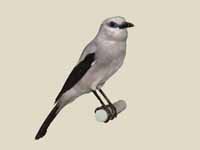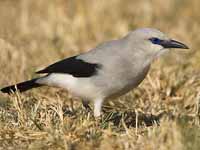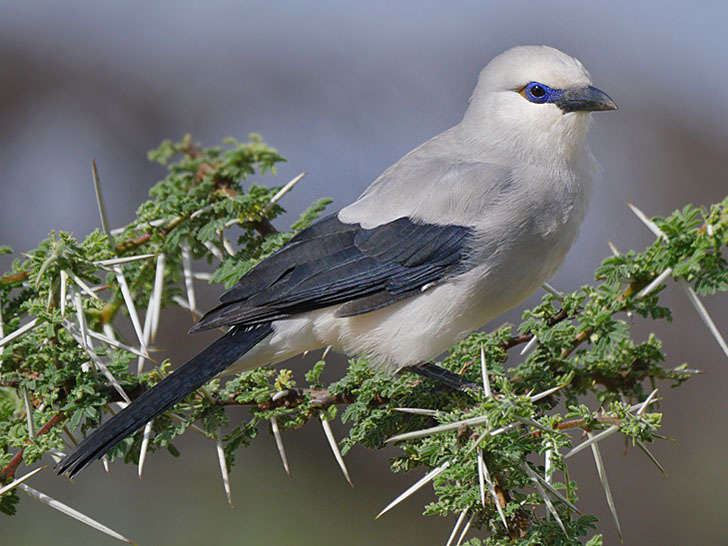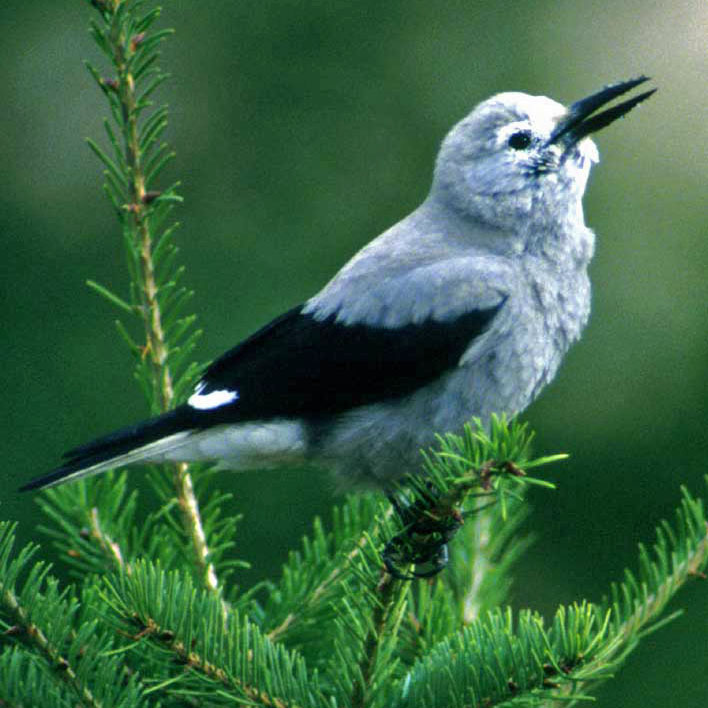The Corvidae family contains the crows, ravens, rooks, jackdaws, jays, magpies, treepies, choughs and nutcrackers. These species are grouped into subfamilies that are outlined in the table that follows. Beware that names such as jays, magpies, or treepies are not always assigned in a consistant manner. For example, the black magpie (Platysmurus leucopterus) belongs to the treepie subfamily.
| SUBFAMILY | MEMBERS |
| Corvinae | True crows of genus Corvus includes the crows, ravens, rooks, jackdaws. |
| Corvinae (continued) | Jays of genus Garrulus, nutcrackers of Nucifraga, magpies of Pica, ground-jays of Jay Podoces, and the piapiac of Ptilostomus, and Stresemann's bush-crow of Zavattariornis. |
| Cissinae | Green-magpies of Cissa and the blue-magpies of Urocissa. |
| Cyanocoracinae | Most of the species that are named "jay". |
| Crypsirininae | Treepies |
| Perisoreinae | Three jay species of Perisoreus and Magpies of Cyanopica |
Corvids are medium to large in size, with strong feet and bills, and a single moult each year (most passerines moult twice). Most species have bristle-like feathers covering their nostrils. They are omnivores having a varied diet of animal and plant material. Makes average slightly heavier than females. Corvids are found worldwide except for the tip of South America and the polar ice caps.
This subfamily contains the genera Garrulus (jays), Podoces (ground-jays), Nucifraga (nutcrackers), Pica (magpies), Ptilostomus (piapac), and Zavattariornis (bushcrow). It also contains the crows of genus Corvus, but they are described in a separate article.
The Garrulus jays are Old World jays. They are mainly found in Europe and Asia, with the Eurasian jay also found in northern Africa. There are only 3 species of Garrulus jays, but the Eurasian jay has almost 30 subspecies, many of which are very distinct. The jays in this genus are similar to the New World jays, both in appearance and behavior. They are colorful and have a large head, robust bill, solid body, plus relatively long tail. They are omnivores eating insects, spiders, lizards, eggs, chicks, nuts, seeds, grains, and fruit. The nests are cup shaped with a base of twigs and lined with softer plant material. It is constructed by both sexes, but onlty the female incubates.
The ground-jays of genus Podoces look and behave differently form the Garrulus jays and also the New World jays. Because they pursue much of their prey on the ground, they have strong legs designed for fast runnin;g and their long, curved thick bills are adapted for digging and probing. Their nests are built in bushes, usually less than 2 meters from the ground. This is not surprising since they are poor fliers and would not want to waste energy flying high into a tree to feed their chicks. The ground-jays inhabit high altitude semi-desert areas from central Asia to Mongolia.
The nutcrackers of genus Nucifraga are found in both the Old World and New World. As their name implies, their preferred food is nuts. But these nuts are not what we traditionlly think of as nuts such as acorns, but seeds from conifers which can also be termed nuts. All three species of nutcrackers live in cold climates and they cache their seeds to insure a year round food supply. By caching their nuts they help propagate their favored conifer species. They also eat insects, larvae, eggs, chicks, and carrion. The nest is usually built high in a conifer.
The magpies of Pica resembles the blue-magpies of Urocissa with their long tails and general shape. Instead of blue, these magpies have predominantly black and white markings. On the other hand, the green-magpies of genus Cissa have their own unique look. The Pica and Urocissa magpies are truly omnivores, seeming equally content to eat animal or plant based food. The green-magpies are mainly carnivores.
Genus Garrulus
Jay,_Black-headed Garrulus lanceolatus
Description: The black-headed jay has mainly greyish-pink plumage. It has a black head and a black tail with fine barring. The throat is black with white streaks. It is 33 cm long and weighs about 95 grams. It nests in trees and bushes.
Range: Eastern Afghanistan and eastwards, across the Himalayas, from India to Nepal and Bhutan,
Habitat: Forests, secondary forests, forest edges and clearings. Also scrub,
Diet: Insects, spiders, nuts, fruit, lizards, eggs, chicks, garbage,
Conservation status: Least Concern.
Image by: 1) Allan Hopkins - India 2) Shrikant_Rao - India 3) Soumendu_Das 4) Srikaanth_Sekar Range: Eastern Afghanistan and eastwards, across the Himalayas, from India to Nepal and Bhutan,
Habitat: Forests, secondary forests, forest edges and clearings. Also scrub,
Diet: Insects, spiders, nuts, fruit, lizards, eggs, chicks, garbage,
Conservation status: Least Concern.
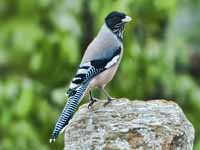
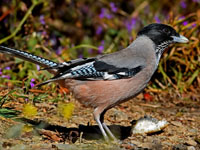
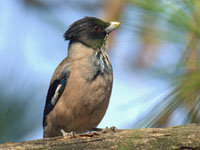
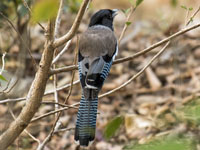
Jay,_Eurasian Garrulus glandarius
Description: The Eurasian jay has pinkish-grey to reddish-brown upperparts. Its throat is white as is the rump. The tail and moustache stripe are black.
Range: Europe, Asia, far northern Africa.
Habitat: Pine-oak forests, forest edges.
Diet: Mainly invertebrates during the breeding season - caterpillars, beetles. During other seasons - acorns, other tree seeds, fruit. Also eggs, chicks. It caches food, especially nuts.
Conservation status: Least Concern.
Image by: 1, 2)_Luc
Viatour 3 Andrej_Chudy - Sloviakia 4) Pete_Beard Range: Europe, Asia, far northern Africa.
Habitat: Pine-oak forests, forest edges.
Diet: Mainly invertebrates during the breeding season - caterpillars, beetles. During other seasons - acorns, other tree seeds, fruit. Also eggs, chicks. It caches food, especially nuts.
Conservation status: Least Concern.
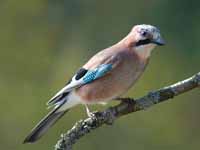

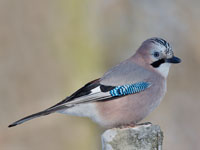
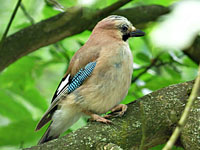
Jay,_Lidth's Garrulus lidthi Found: Japan
Description: The Lidth's Jay has mainly chestnut and purple plumage. The head is mainly purple with black on the forehead and chin. There is also varying amounts of purple on the breast. It is 38 cm long and weighs 125 grams.
Range: Southern Japanese islands of Amami Oshima and Tokunoshima,
Habitat: Pine forest, sub-tropical woodland and cultivated areas, especially around villages.
Diet: Mainly acorns; also small reptiles and invertebrates of many types.
Conservation status: Least Concern.
Image by: 1) MaterialScientistRange: Southern Japanese islands of Amami Oshima and Tokunoshima,
Habitat: Pine forest, sub-tropical woodland and cultivated areas, especially around villages.
Diet: Mainly acorns; also small reptiles and invertebrates of many types.
Conservation status: Least Concern.
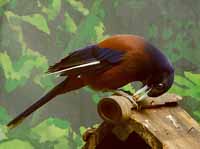
Genus Podoces
The ground-jays inhabit high altitude semi-desert areas from central Asia to Mongolia. They show adaptations to ground living such as long, strong legs designed for fast running and the ability to leap and bound onto boulders and rocks with great agility. Their long, curved thick bills are adapted for digging and probing. While capable of flight (which they do infrequently and relatively weakly), they prefer running, and will readily perch on trees and bushes also.
Jay,_Mongolian ground- Podoces hendersoni
Description: The Mongolian ground-jay, also known as the Henderson's ground-jay, has mainly tan plumage. It has black and blue on the flight feathers, a black forehead, and relatively long and curved black bill. It is about 28 cm long and 120 grams in weight. The Mongolian ground-jay prefers to run rather than fly from danger.
Range: Mainly Mongolia; also China, Kazakhstan, and Russia,
Habitat: Open and dry country with scattered shrubs.
Diet: Insects, beetles, lizards, seeds, grain.
Conservation status: Least Concern.
Image by: 1) Jargal Lamjay 2) Sergey_PisarevskiyRange: Mainly Mongolia; also China, Kazakhstan, and Russia,
Habitat: Open and dry country with scattered shrubs.
Diet: Insects, beetles, lizards, seeds, grain.
Conservation status: Least Concern.
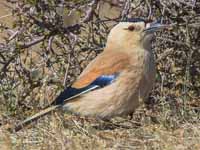
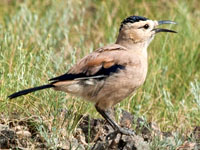
Jay,_Pleske's Ground- Podoces pleskei
Description: The Iranian ground-jay, also known as the Pleske's ground-jay has mainly light brown plumage. It has black lores, a black patch on its upper-breast, black bill, and black feet. The wings are black and white. It is 24 cm long and a little under 100 grams.
Range: Iran.
Habitat: Open and dry country with scattered shrubs,
Diet: Mainly insects in the spring. Also lizards, seeds, grain,
Conservation status: Least Concern.
Image not available.Range: Iran.
Habitat: Open and dry country with scattered shrubs,
Diet: Mainly insects in the spring. Also lizards, seeds, grain,
Conservation status: Least Concern.
Jay,_Turkestan Ground- Podoces panderi
Description: The Turkestan ground-jay, also known as the Pander's ground-jay, has blue-grey upperparts and tan underparts. It has black lores, upper-tail, and a black upper-breast patch. The Turkestan ground-jay is 25 cm long and weighs a little under 100 grams. The nest is usually 1 to 2 meters above the ground, but may even be on the ground. Female incubates for about two and a half weeks, then both parents feed the chicks for about a similar period of time before they feldge.
Range: Central Asia. In particular Kazakhstan, Turkmenistan, and Uzbekistan.
Habitat: Sandy desert with brushy cover. Avoids forests.
Diet: Primarily animals such as ants, beetles, spiders, scorpions in spring. Other times mostly vegitarian,
Conservation status: Least Concern.
Image by: 1) Alastair Rae 2) Francesco Veronesi - UzbekistanRange: Central Asia. In particular Kazakhstan, Turkmenistan, and Uzbekistan.
Habitat: Sandy desert with brushy cover. Avoids forests.
Diet: Primarily animals such as ants, beetles, spiders, scorpions in spring. Other times mostly vegitarian,
Conservation status: Least Concern.
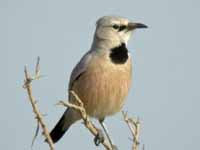
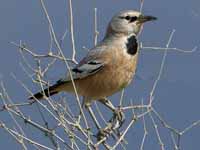
Jay,_Xinjiang Ground- Podoces biddulphi
Description: The Xinjiang ground-jay, also known as the Biddulph's ground-jay, has mainly light brown plumage, a black crown, black cheek patch, anda blackish throat. It has a long and curved bill. It is about 29 cm in length and weighs 120 to 140 grams.
Range: Taklimalso known asn Desert in China.
Habitat: Desert with some vegetation.
Diet: Its long curved bill aids the digging of insects in the sand. Also eats seeds and grains.
Conservation status: It is listed as Near Threatened due to a very large increase in human population in its range.
Image by: 1) John Gerrard Keulemans 2) P_Khoo Range: Taklimalso known asn Desert in China.
Habitat: Desert with some vegetation.
Diet: Its long curved bill aids the digging of insects in the sand. Also eats seeds and grains.
Conservation status: It is listed as Near Threatened due to a very large increase in human population in its range.
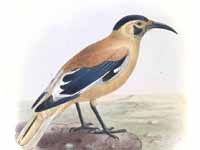
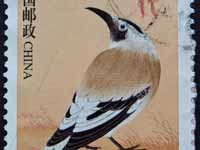
Genus Nucifraga
The bills of nutcrackers are specialized tools for extracting seeds (nuts) from pine cones. Surplus seed is stored for later use, and this genus is helps re-establishment of their favored pines after fires and deforestation. They also eat insects, larvae, eggs, chicks, amd carriom. Breeding is always early so as to make the best use of pine nuts stored the previous autumn. The nest is usually built high in a conifer. There are normally 2–4 eggs laid and incubated for 2 to 3 weeks.
Nutcracker,_Clark's Nucifraga columbiana
Description: Clark's nutcracker
has a grey body with black wings and tail, a white rump, black biil, and black feet. It is about 29 cm long. Nests are constructed in conifers; both sexes incubate the eggs which hatch after about 3 weeks. The similar Canada jay does not have black on its wings.
Range: Northwest North America.
Habitat: Alpine conifer forests. In the summer, they may move up close to the tree line.
Diet: Mainly pine seeds. It caches them for the winter and has a great memory for where they were stored. Also eats insects, fruit.
Conservation status: Least Concern.
Image by:
1) Alan D Wilson - Oregon
2) Eugene_Beckes 3) Donald_Hobern - Colorado 4) Aaron_Maizlish - NevadaRange: Northwest North America.
Habitat: Alpine conifer forests. In the summer, they may move up close to the tree line.
Diet: Mainly pine seeds. It caches them for the winter and has a great memory for where they were stored. Also eats insects, fruit.
Conservation status: Least Concern.
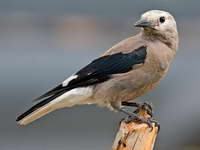
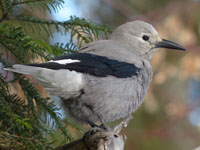
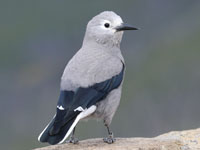
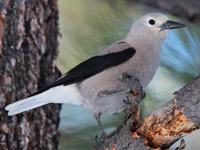
Nutcracker,_Kashmir also Large_Spotted Nutcracker Nucifraga multipunctata
Description: The Kashmir nutcracker, also known as the large spotted nutcracker, has a blackish crown and nape. The body has heavy white streaking, spotting, and striping. It is 32 to 35 cm long. The nests are made out of twigs, decorated with lichens, and are lined with soft roots and pine needles.
Range: Western Himalayas.
Habitat: Conifer forests; also mixed conifer and oak.
Diet: Mainly conifer seeds and acorns.
Conservation status: Least Concern.
Image by: 1) John_Gould 2, 3) Imran_Shah - PakistanRange: Western Himalayas.
Habitat: Conifer forests; also mixed conifer and oak.
Diet: Mainly conifer seeds and acorns.
Conservation status: Least Concern.
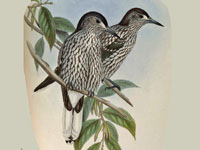
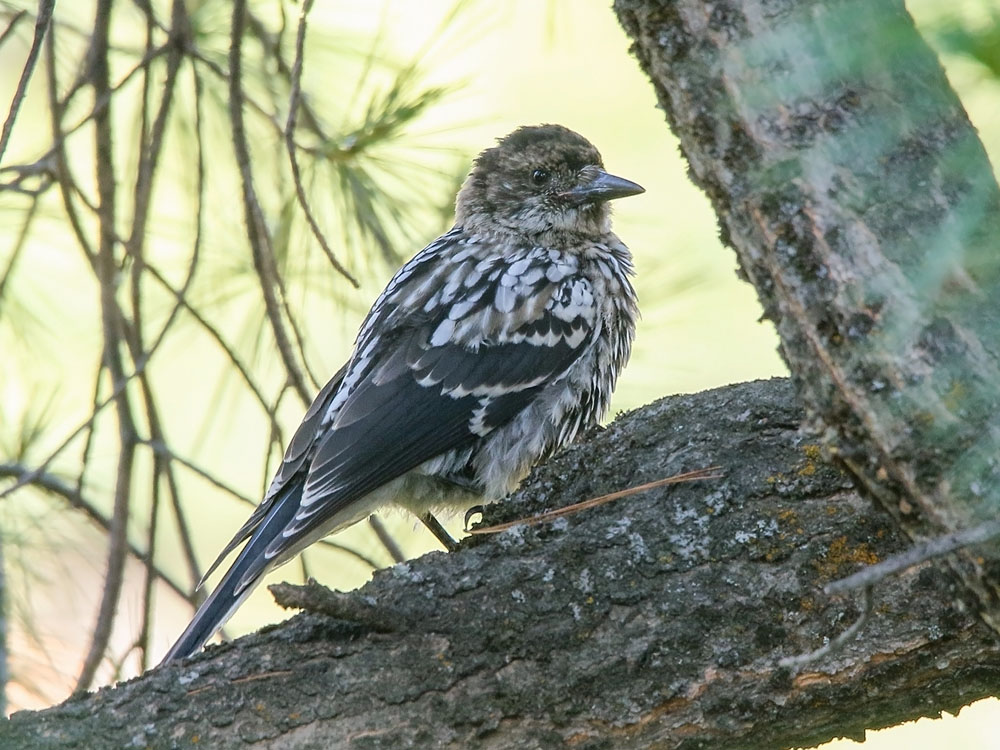
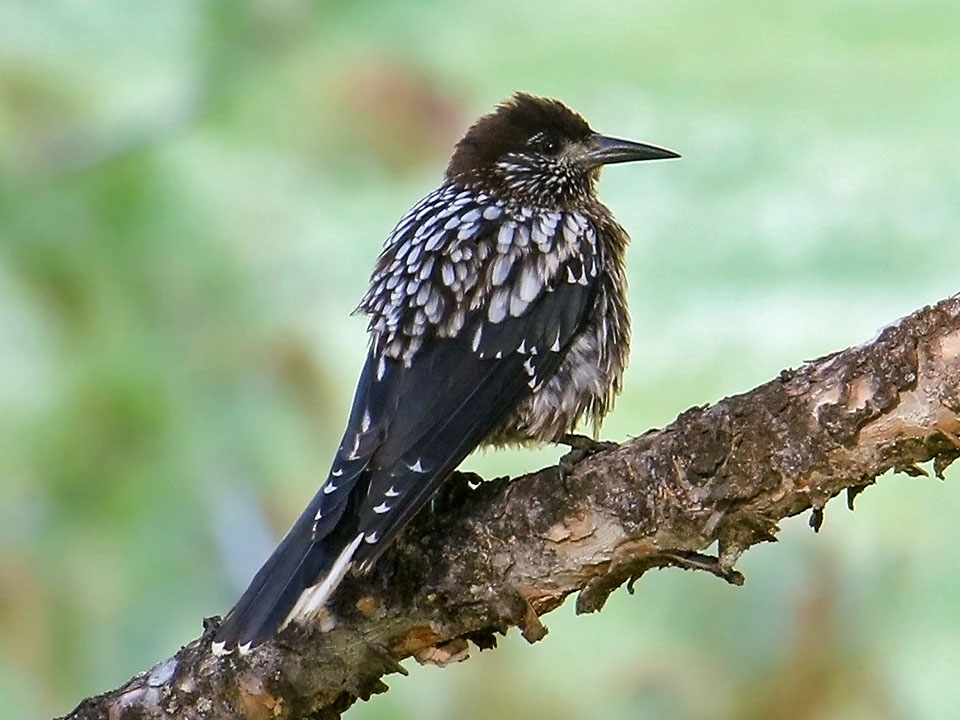
Nutcracker,_Spotted Nucifraga caryocatactes:
Description: The spotted nutcracker, also known as the Eurasian nutcracker, is mainly chocolate brown with white spots and white streaks. The wings and upper-tail are blackish. It has a white loral spot, eye-ring, rump, and the of the tai is also whitel. The iris, legs and feet are black. The spotted nutcracker is 32 to 38 cm long which makes it the largest of the nutcrackers.
Range: Europe, Asia
Habitat: Forests with pine and spruce. Also nut bearing deciduous trees. Usually in the mountains
Diet: Mainly pine seeds. Also spruce seeds, acorns, insects, eggs, chicks, small birds, carrion. It caches seeds for use in the winter.
Conservation status: Least Concern.
Image by: 1 ) Staszek99 2) MurrayBHenson - Poland 3) Arto_Huotari - Finland 4) Aaron_Maizlish - SwitzerlandRange: Europe, Asia
Habitat: Forests with pine and spruce. Also nut bearing deciduous trees. Usually in the mountains
Diet: Mainly pine seeds. Also spruce seeds, acorns, insects, eggs, chicks, small birds, carrion. It caches seeds for use in the winter.
Conservation status: Least Concern.
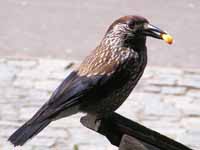
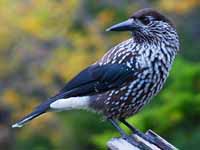
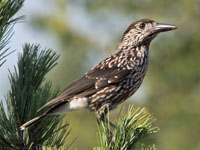
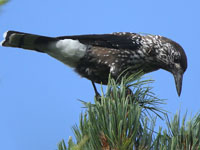
Genus Pica
There are more magpies in subfamilies Cissinae and Perisoreinae.
Many of the species in this genus are related to the Eurasian magpie (Pica pica). The two maps below, created by Schroeder, show the locations of some species related to Pica pica and also some subspecies of Pica pica.
Left image: Pica pica, P. p. fennorum, P. p. melanotos, P. p. bactriana, P. mauritanica (Maghreb magpie)
Right image: P. p. bactriana, P. p. leucoptera, P. leucoptera (Black-rumped magpie), P. serica (Oriental magpie), P. p. camtschatica - shown in dark blue.
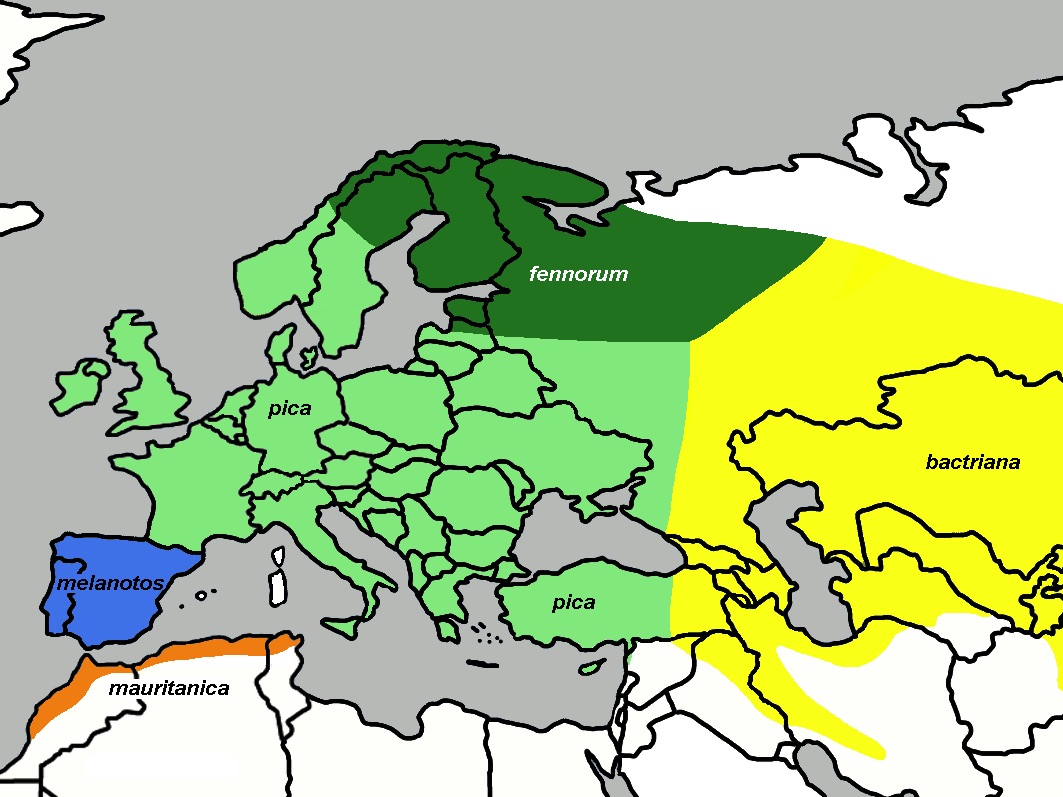
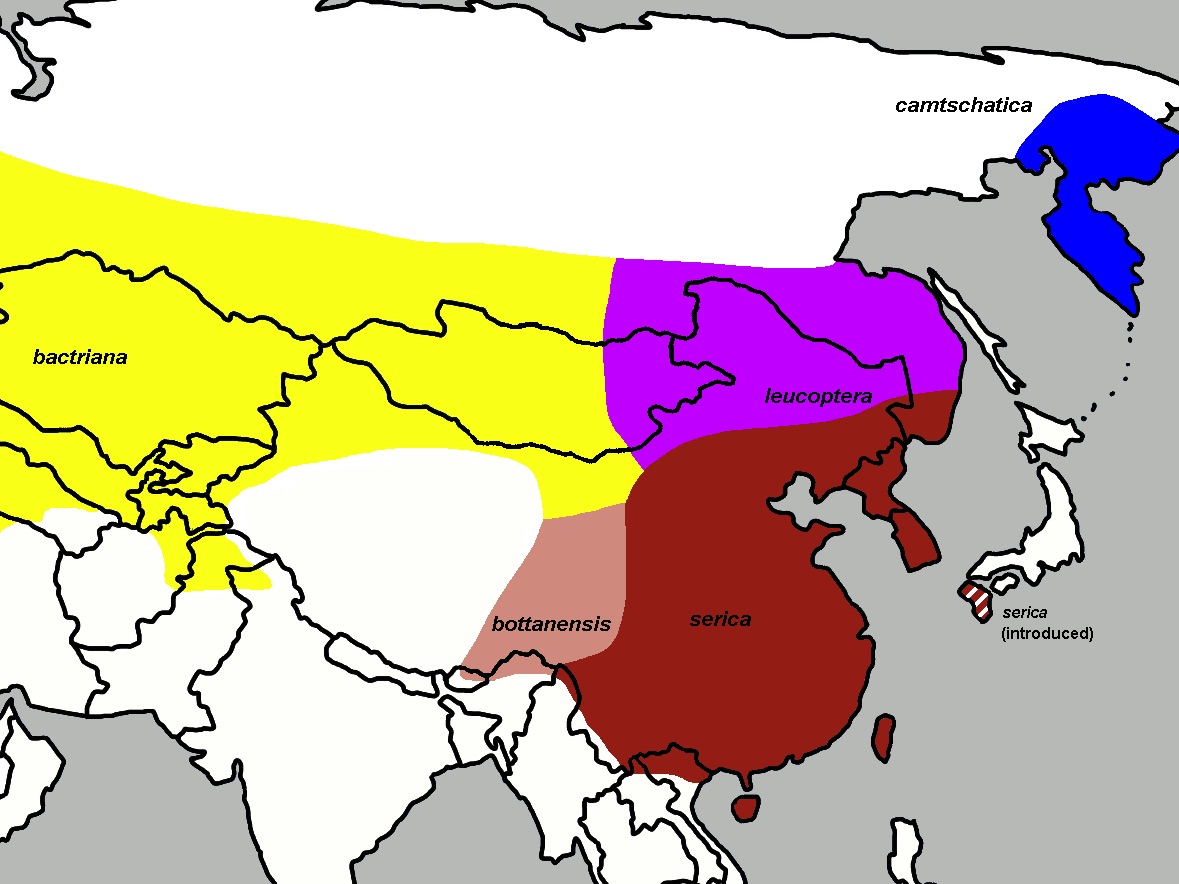
Magpie, Asir Pica asirensis
Description: The Asir magpie is also considered to be a subspecies of Eurasian Magpie (Pica pica). It has a longer bill, darker plumage, and darker iris.
Range: Asir Range in Saudi Arabia.
Habitat: African juniper forests.
Diet: In the summer mainly invertebrates, lizards, frogs. Otherwise the diet is plant based, for example seeds,
Conservation status: It is listed as Endangered because the population is under 500 due to habitat destruction.
Images not available.Range: Asir Range in Saudi Arabia.
Habitat: African juniper forests.
Diet: In the summer mainly invertebrates, lizards, frogs. Otherwise the diet is plant based, for example seeds,
Conservation status: It is listed as Endangered because the population is under 500 due to habitat destruction.
Magpie,_Black-billed Pica hudsonia
Description: The black-billed magpie has a black bill, head, mantle, breast, eyes, and legs. The belly is white, the wings are dark blue-green as is the long tail. It is simi,ar to the common magpie. but their ranges do not overlap. It is 45 to 60 cm long and weighs 150 to 200 grams. The nest is made out of branches and twigs which may be lined with needles, grass and other soft material. New nests may be built over old ones and reach a meter in diameter. The female incubates the eggs for 2 to 3 weeks and they take another 3 to 4 weeks to fledge.
Range: Western and central North America.
Habitat: Near streams in grasslands and thickets.
Diet: Insects, carrion, grain.
Conservation status: Least Concern.
Image by: 1 ) Dick Daniels - Wyoming 2) Chuck Roberts - Colorado 3) Dick - Alaska 4) Alan Wilson - British ColumbiaRange: Western and central North America.
Habitat: Near streams in grasslands and thickets.
Diet: Insects, carrion, grain.
Conservation status: Least Concern.
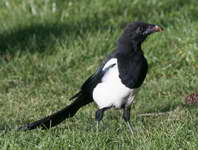
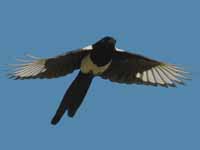
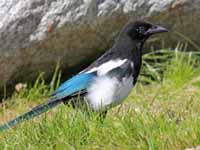
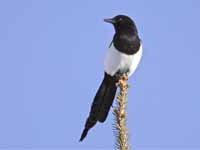
Magpie,_Black-rumped Pica bottanensis
Description: The black-rumped magpie is also considered to be a subspecies of Eurasian Magpie (Pica pica). It has a black rump instead of a white rump. There is very little gloss on the plumage.
Range: Central Bhutan to west-central China,
Habitat: Needs some trees, but avoids dense forests.
Diet: Omnivore.
Conservation status: Not listed.
Image by: 1) Dibyendu Ash - BhutanRange: Central Bhutan to west-central China,
Habitat: Needs some trees, but avoids dense forests.
Diet: Omnivore.
Conservation status: Not listed.
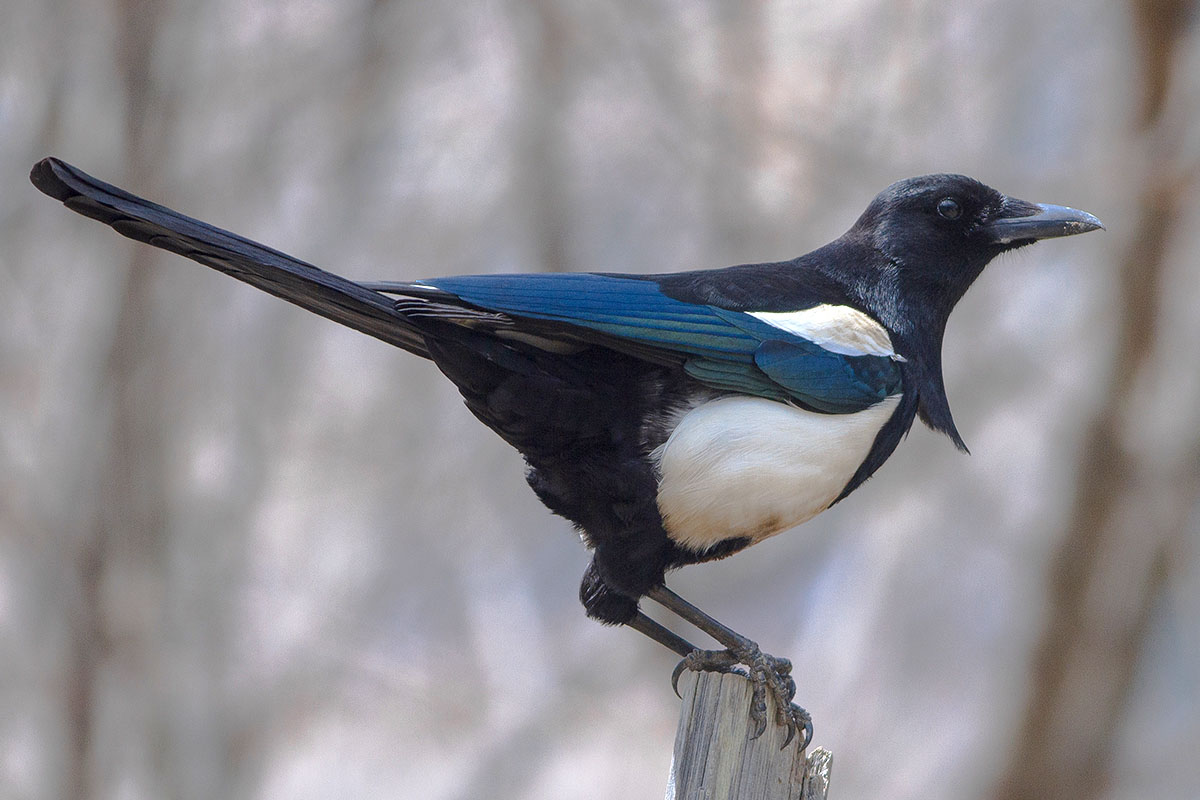
Magpie,_Eurasian Pica pica
Description: The Eurasian magpie, also known as the common magpies, has black upperparts, head, breast, tail, eyes, and legs. It has white shoulders and belly. The wings are black with white primaries. The wings and back are glossed with a green and violet sheen. It is 46 to 50 cm long and weighs 160 to 240 grams. It is similar to the black-billed magpie, but the ranges do not overlap.
Range: Europe, Asia, Africa.
Habitat: Open habitat with scattered trees.
Diet: Insects, acorns, grain, eggs, chicks, carrion.
Conservation status: Least Concern.
Image by: 1) Dick Daniels - England 2) David_Merrett 3) Agustin_Povedano 4) Erik Jergensen Range: Europe, Asia, Africa.
Habitat: Open habitat with scattered trees.
Diet: Insects, acorns, grain, eggs, chicks, carrion.
Conservation status: Least Concern.
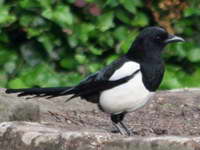
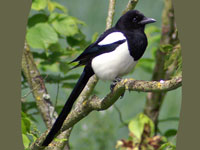
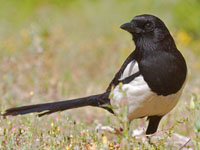
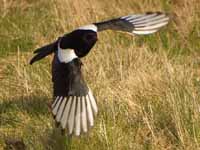
Magpie,_Maghreb Pica mauritanica
Description: The Maghreb magpie can be distinguished from the Eurasian magpie (Pica pica) by the patch of blue skin behind its eye, the narrower white belly, the shorter wings, and the longer tail.
Range: North Africa from Morocco east to Tunisia.
Habitat: Needs some trees, but avoids dense forests.,
Diet: Beetles, lizards, frogs, eggs, chicks, fruit, seeds, carrion.
Conservation status: Least Concern.
Image by: 1) Charles_Sharp - Morocco 2) Panegyrics_of_Granovette - MoroccoRange: North Africa from Morocco east to Tunisia.
Habitat: Needs some trees, but avoids dense forests.,
Diet: Beetles, lizards, frogs, eggs, chicks, fruit, seeds, carrion.
Conservation status: Least Concern.
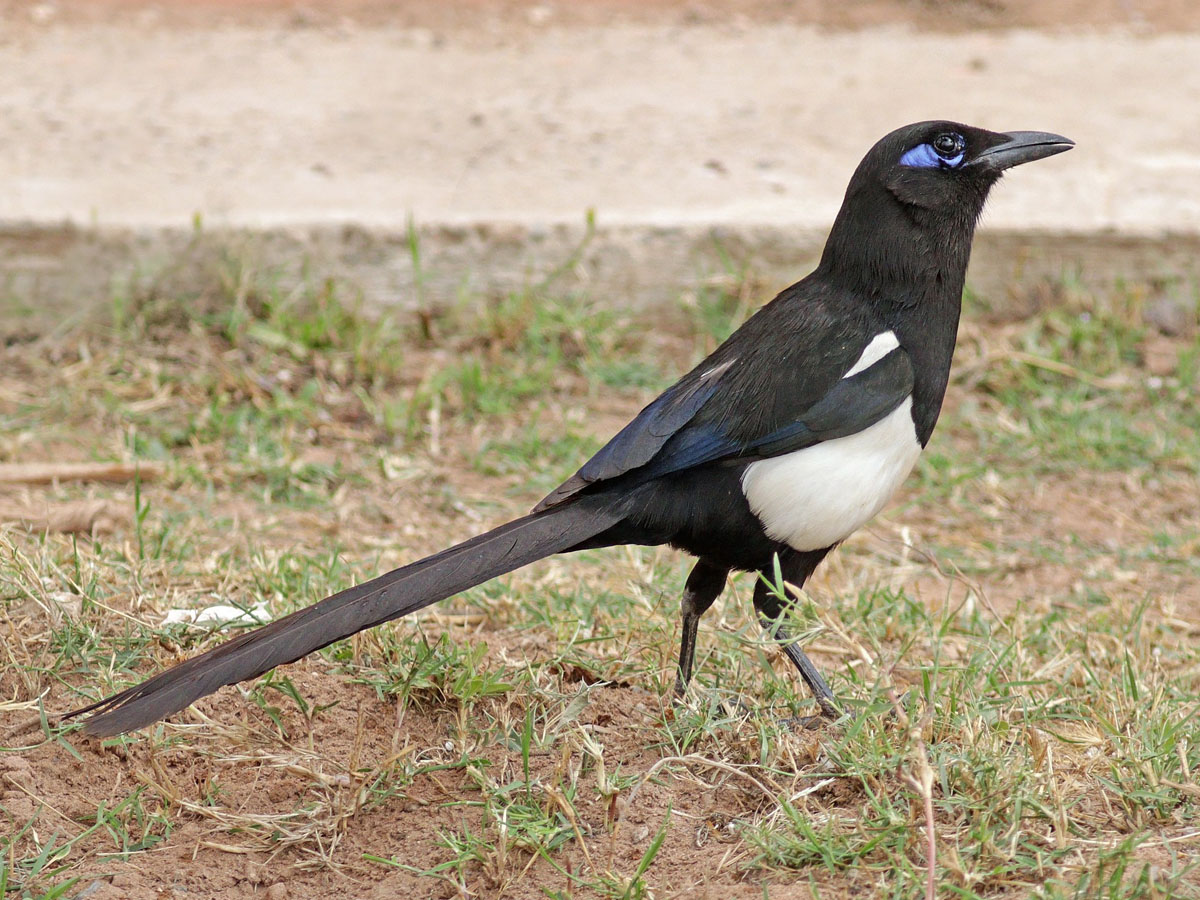
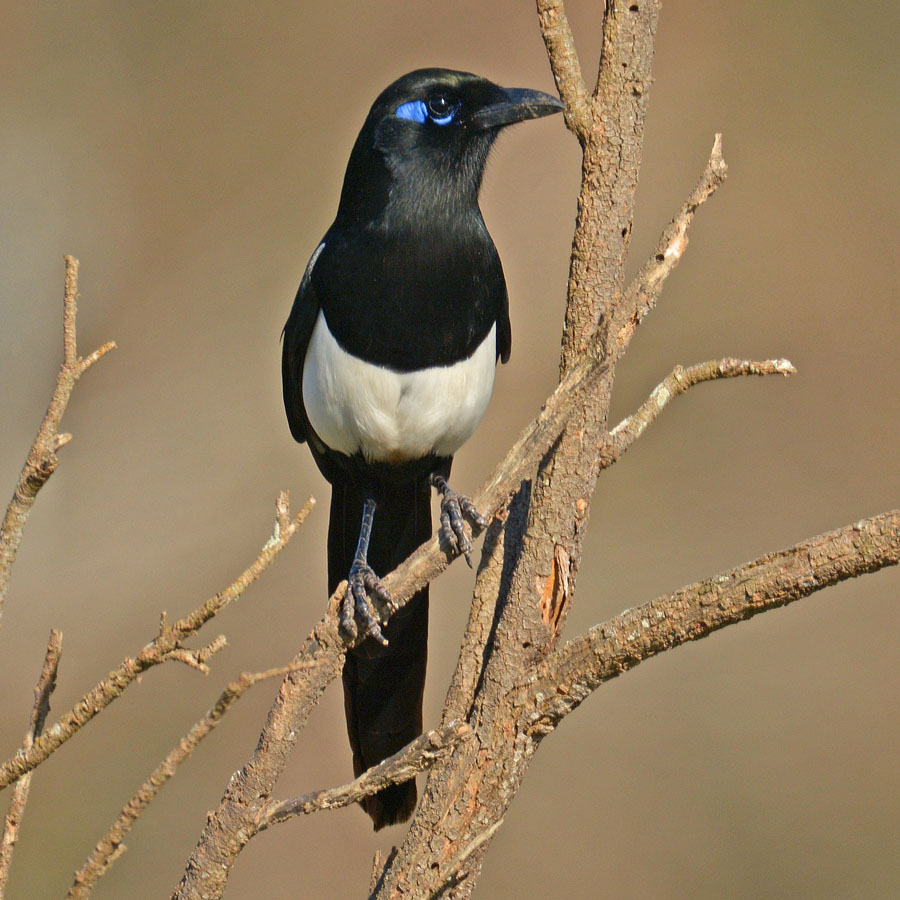
Magpie, Oriental Pica serica
Description: The Oriental magpie is very similar to the Eurasian magpie (Pica pica):, but it has a shorter tail and there is a greener gloss on the secondaries.
Range: Myanmar to eastern China, Korea, Taiwan.
Habitat: Very varied but requires scattered trees,
Diet: Beetles, lizards, frogs, eggs, chicks, fruit, seeds, carrion.
Conservation status: Least Concern.
Image by: 1) Yoo_Chung - South Korea 2) Charles_Lam - Hong KongRange: Myanmar to eastern China, Korea, Taiwan.
Habitat: Very varied but requires scattered trees,
Diet: Beetles, lizards, frogs, eggs, chicks, fruit, seeds, carrion.
Conservation status: Least Concern.
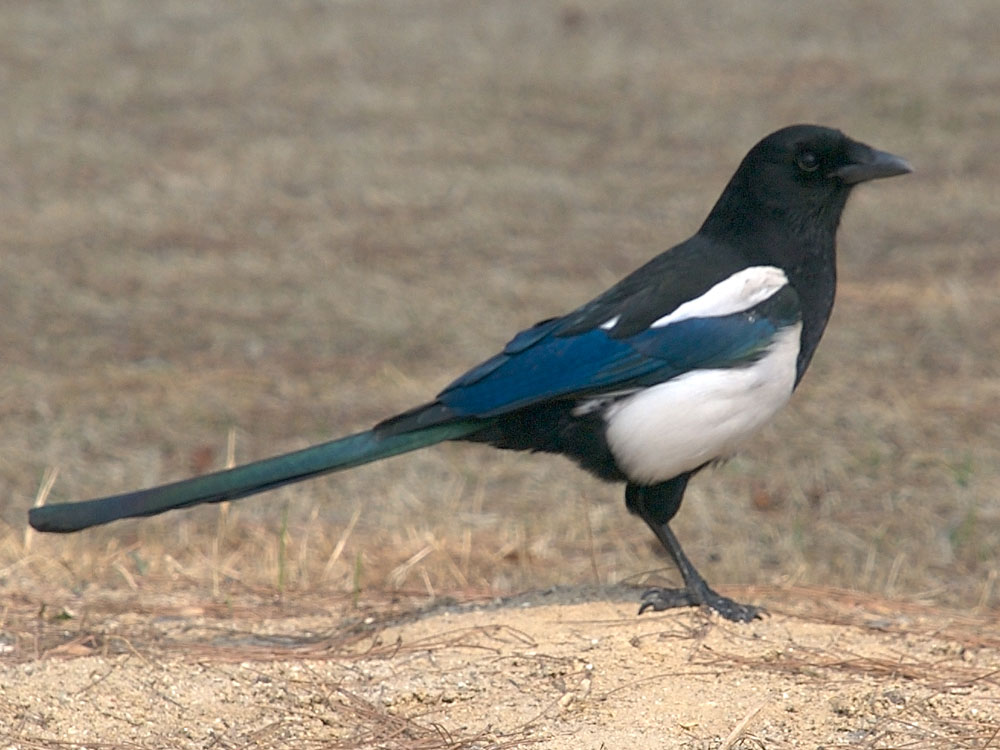
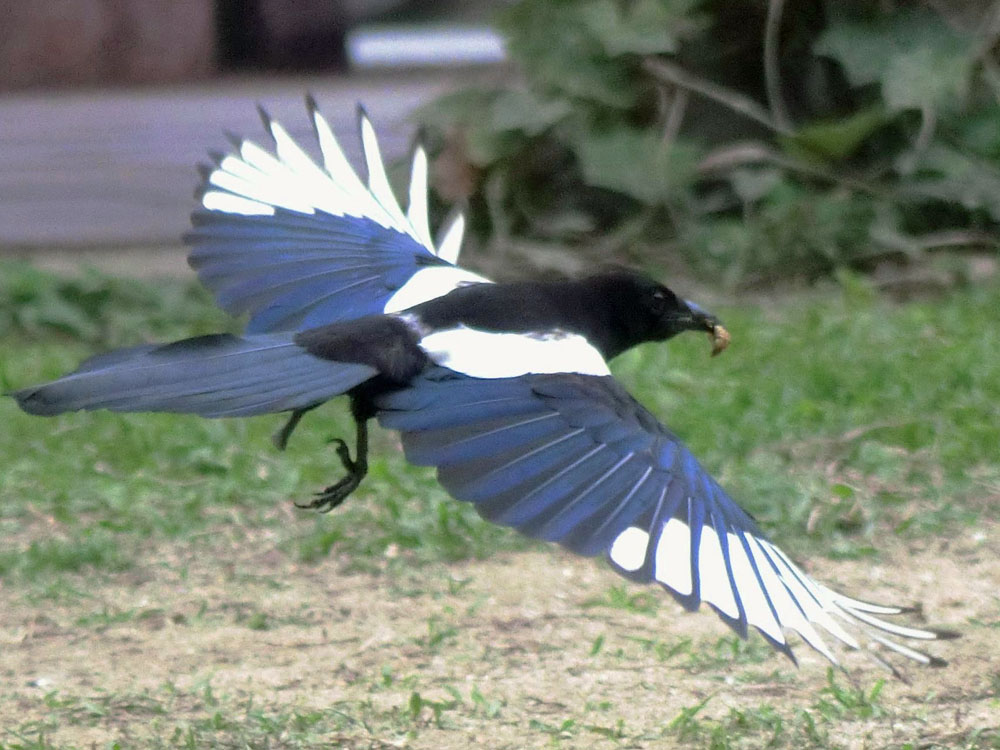
Magpie,_Yellow-billed Pica nuttalli
Description: The yellow-billed magpie has a yellow bill. It has a black head, mantle, and breast. The eyes and legs are black and the belly is white. It has dark blue-green wings, and a long black tail. Some have yellow around the eyes. It is 43 to 54 cm long and weighs 150 to 170 grams which makes it smaller than the black-billed magpie. The yellow-billed magpie is adapted to the hot summers of California's Central Valley and experiences less heat stress than the black-billed magpie.
Range: California.
Habitat: Grassy with oak trees present.
Diet: Mainly insects, especially grasshoppers. Also carrion, acorns, fruit, carrion, garbage at landfills.
Conservation status: It is listed as vulnerable because of fewer oak trees.
Image by: 1) Linda Tanner 2) Greg Schechter 3) Bill_Bouton 4) Jerry Kirkhart Range: California.
Habitat: Grassy with oak trees present.
Diet: Mainly insects, especially grasshoppers. Also carrion, acorns, fruit, carrion, garbage at landfills.
Conservation status: It is listed as vulnerable because of fewer oak trees.
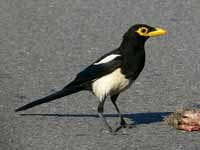
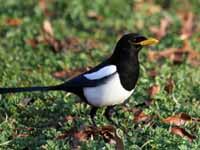
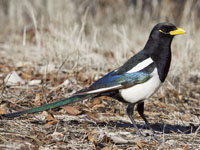
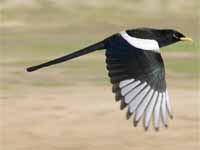
Genus Ptilostomus - 1 species
Piapiac Ptilostomus afer
Description: The piapiac has mainly black plumage, a brownish-black tail, black bill, and black legs. It is an agile runner and its nearest relatives are the ground-jays. It often nests in a palm tree and uses mud to cement palm leaves and grass to create its nest.
Range: Tropical Africa.
Habitat: Mainly grasslands.
Diet: Mainly insects and other invertebrates it catches on the ground. Also carrion and fruit.
Conservation status: Least Concern.
Image by: 1) JV Verde - Gambia 2) Thomas Brown - Gambia 3) Nik_Borrow - UgandaRange: Tropical Africa.
Habitat: Mainly grasslands.
Diet: Mainly insects and other invertebrates it catches on the ground. Also carrion and fruit.
Conservation status: Least Concern.
3) On a warthog
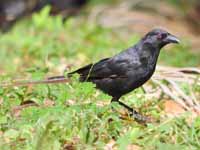
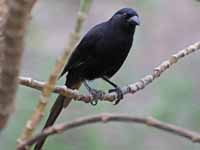
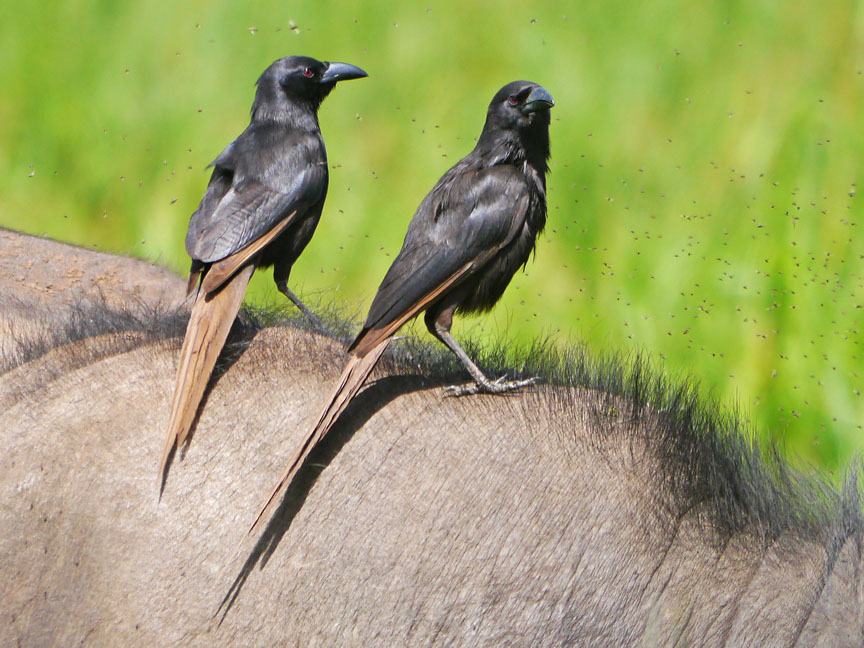
Genus Zavattariornis - 1 species
Crow,_Stresemann's Bush- Zavattariornis stresemanni
Description: The Stresemann's bush-crow has mainly bluish-grey plumage, creamy-white throat and breast, glossy black wings, and brown eyes surrounded by bright blue skin. The Stresemann's bush-crow is 28 cm long and weighs about 130 grams. It resembles a starling and will associate with them, but DNA suggests it belongs to the crow family.
Range: southern Ethiopia.
Habitat: Flat savanna covered with mature acacia and Commiphora thornbushes.
Diet: Digs in soil to unearth insects, obtains parasites from the backs of of cattle. It will also take flying leaps after flying insects.
Conservation status: It is listed as Endangered because of its limited range.
Image by: 1) Dick Daniels - specimen in Nairobi National Museum, Kenya 2) Sandy Wall 3) Nik_BorrowRange: southern Ethiopia.
Habitat: Flat savanna covered with mature acacia and Commiphora thornbushes.
Diet: Digs in soil to unearth insects, obtains parasites from the backs of of cattle. It will also take flying leaps after flying insects.
Conservation status: It is listed as Endangered because of its limited range.
